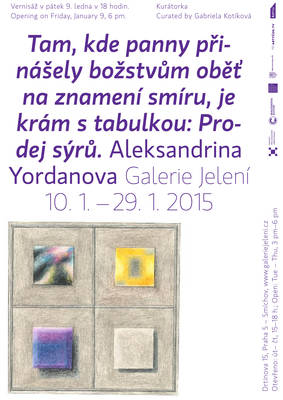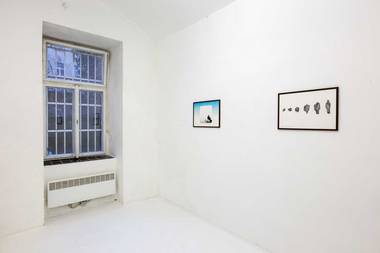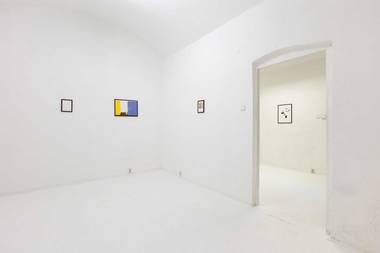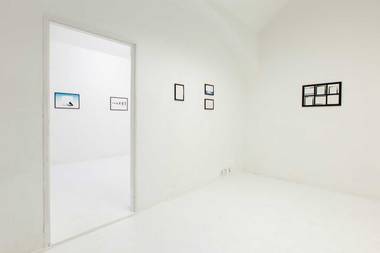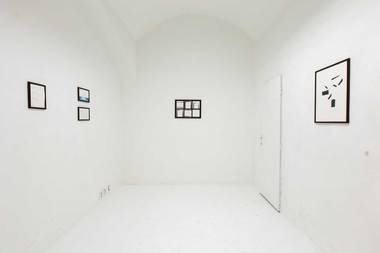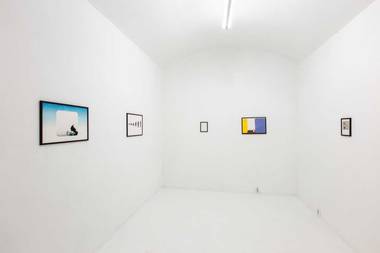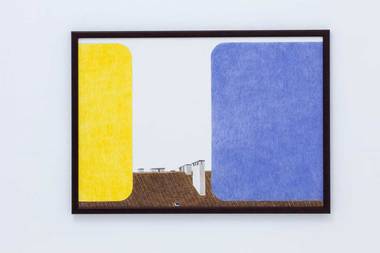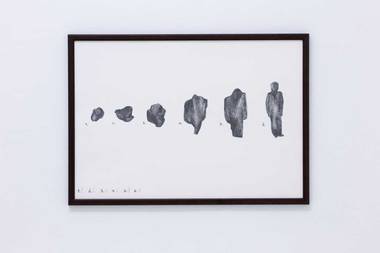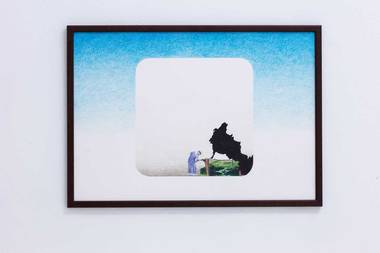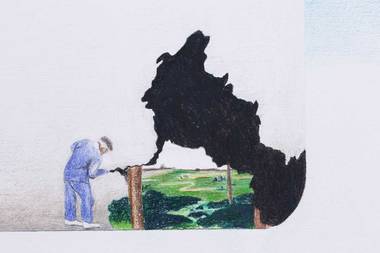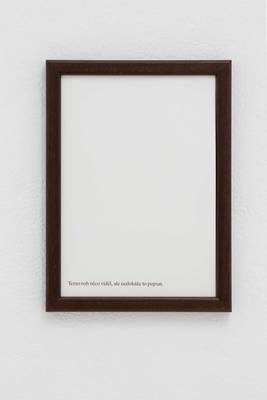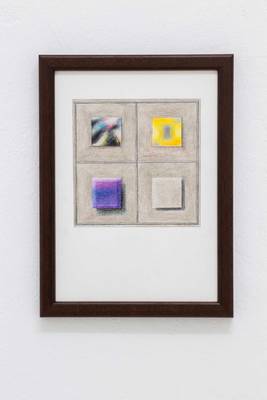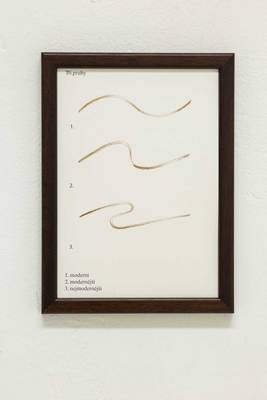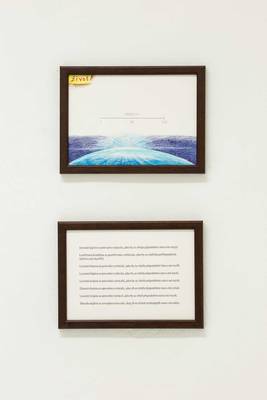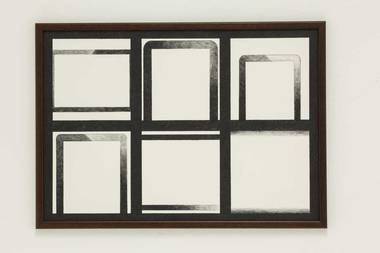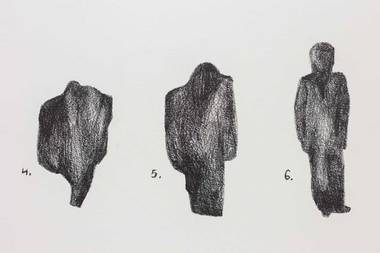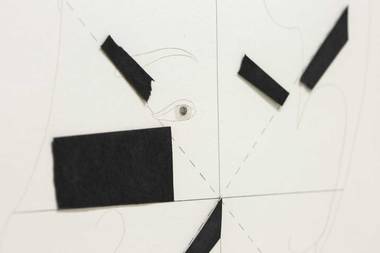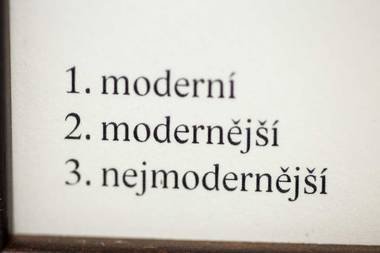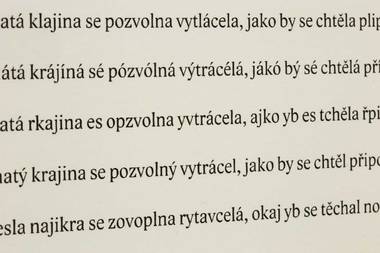Aleksandrina Yordanova: In the place where virgins used to bring sacrifices to the Gods as a sign of reconciliation, there’s a shop with a sign: Cheese for sale.
10. 1. – 29. 1. 2015
opening: 9. 1. 2015
curator: Gabriela Kotiková
Interview by curator Gabriela Kotiková with artist Aleksandrina Yordanova
Gabriela Kotiková: Alexandrino, you come from Bulgaria, where exactly is your family from?
Aleksandrina Yordanová: I come from the north-east part of Bulgaria from the town of Targovište. It has a population of about 40 thousand people; it is located in the Danube lowland area in the area of Mountain Stara Planina, about 80 km from the sea. My father and part of our family come from the same town. My mother comes from the city of Salsk from the Rostov region in Russia.
GK: How old were you when you moved to the Czech Republic? What were your impressions? Were you glad or was it difficult to say good-bye to your birthplace? Usually it can be an adventure for children to move somewhere.
AY: We left when I was 12. First my mother left the country for a few years. In the beginning we did not know that she was in the Czech Republic. My parents kept it a secret for some time. They had to be very careful. They did not know anyone in the Czech Republic and it was quite risky for them. Back then we did not have any other communication channels than the telephone and we used to see our mom once a year. Then my dad and I followed her about four years later. Back then it was everyone’s dream to leave our country. I didn’t regret so much that we were leaving. I had pretty high expectations. And then I was disappointed from the big city and from the loss of security. As well as from the food :)
GK. Were your parents artistically oriented?
AY: No, no one in my family is an artist.
GK: What secondary school did you study in the Czech Republic? Did it have some artistic focus? And can you tell me if it was important for you and what it gave you?
AY: I studied at a secondary school for textile crafts in Prague. I relate to the fact that I was forced to change Bulgarian for Czech. In the beginning I was not stressed about it – the language seemed quite similar to me. But then I realized that it is very specific and especially that I have to change my way of thinking. It was not the language that made me feel different.
GK: You first studied at a university in Ustí nad Labem. Can you compare that school with the Academy of Arts, Architecture and Design where you later transferred to?
AY: In Ústí nad Labem I studied for four years in the studio of Jaroslav Prášil and that was a good experience. It is difficult to specify the focus of the studio. Originally Mr. Prášil founded this studio while he was still teaching at the Pedagogic Faculty and it was one of the first studios prior to the founding of the Department of Applied Arts at FUD. When the assistant Robert Vlasak joined the studio, it started to have a rather sculpting focus. I think that the curriculum was still kept. For example, semesters worked in a way that we got topics that we had to later defend, which was often a problem for us. I even think that we were limited when we applied our own opinions. Usually there was no discussion during consultation, only rarely. We went over the works that we did only formally. At the Academy of Arts, Architecture and Design (UMPRUM) it was the opposite; it was our approach that mattered the most.
GK: How did you reach the decision that you would like to study in the studio of Jiří Černicky? Where you deciding between other studios as well?
AY: I did not hesitate for one second. I knew that I wanted to study with Jiří Černicky. It was about a year or two after he started teaching there with Marek Meduna as his assistant. I was glad to find out that the head of painting at UMPRUM is no longer Stanislav Diviš and that it’s Jiří Černický. I must admit that I did not expect to get accepted there and I couldn’t believe it for the next half a year.
When I lived in Ústí where the galleries present rather artists from Prague or Brno, as well as international artists, I had this feeling of inaccessibility. Maybe it’s also because students from Prague get more attention from the artistic “elite”. An important difference was also in the theoretical studies at the two schools. In comparison to the studies at UMPRUM the studies in Ústí were almost absurd. Besides art history and aesthetics there were not subjects that touched anything that interested me.
GK: At UMPRUM did you feel that your studio was where it was all happening, or where you also interested in other studios?
AY: In Ústí it was more about friends, parties, openings. At UMPRUM I really enjoyed the school. There were good lectures. During the first semester I even attended lectures on subjects that I was not enrolled in because I thought that it all interested me. Maybe even for the reason that I felt sorry about the fact that I would study there so shortly.
I felt comfortable with my classmates in our studio, I think that we all got along quite well. That was in the first year; there were a lot of us new students, so I didn’t feel like an outsider. But everything changed a lot every year with the new students coming. Also the studio got bigger in capacity and became more hectic. I actually regret not taking a guest term in another studio. That’s the only thing I would probably do differently. But it’s probably also due to the fact that I studied there so shortly. All of the studios seemed interesting to me but I would probably not change any for Jirka-Marek’s studio. There was also a period when the studio heads rotated. It lasted about three weeks and happened once a year. We were able to meet other professors and they got to know us. This really helped with the communication at the final exams, it was more relaxed.
GK: Did you visit exhibitions at Dokumenta in Kassel or Biennale in Venice? What was your impression from these great exhibitions? Do you remember any works that captivated you?
AY: I went to the Biennale in Venice twice – first in 2011. I was intrigued by the work by James Turrell, which was something like a fusion of light, space and colour. I also liked the works by Nicolás Paris who works with text, actually he basically had only text there. I like the fact that I can imagine all sorts of things. That is also one of the reasons why I like to use text myself. Originally, I got the idea to use text from Nedko Solakov, who uses text to comments his installations. I like him a lot.
Other authors that made an impression on me at the Biennale included Nathaniel Mellors who exhibited his film “Ourouse” , and I also remember well installations by Thomas Hirschhorn. At the second Biennale I liked the most the works by the duo Jos De Gruyter and Harald Thys, Yuksel Arslan from Turkey, Harry Smith, Camile Henrot, Jeremy Deller, Ryan Trecartin, Jose Antonio Suarez Londono, Neil Beloufa...
GK: Are you following the contemporary art scene in Bulgaria? Do you know any artists there, or was it difficult to maintain contact in this area? Do you visit your family there regularly?
AY: I go there almost every summer but I know very little contemporary art in Bulgaria. I like the work of Nedko Solakov whom I have already mentioned. Other young artists that I know are not that famous, for example, Vikenty Komitský whom I met several years ago in Gallery ETC. I have some information from the magazine Edno – I like the artist Plamen Deanov, for example. I was also quite interested in East Art Map at one point, there is a lot of information about artists from Eastern Europe, including Slovakia and the Czech Republic
GK: I really liked your thesis work where you worked with drawing, as well as texts. Your work is conceptual but at the same time an important role is played there by delicate drawing. Your work is partly poetic, as well as humorous. Does your current work that you did for the Gallery Jeleni follow up on your thesis work?
AY: I used this type of drawing in my thesis for the first time. I didn’t plan to necessarily continue using it, but I have the feeling that it’s a topic I’d like to keep working with. In my thesis I treated the topic of emptiness that was instigated by Ilya Kabakov’s text, where he describes emptiness as something that we’re not aware of, as an unknown space, an illusion. In the project for Gallery Jeleni I included in my drawings also computer visualizations. The most common element that I use is the shape of an icon, which is a certain visual symbol that doesn’t mean anything on its own. It’s something like a form that can be filled with many different functions and meanings.
GK: It seems to me that some of your work also refers to the works of Viktor Pivovarov, although they are also very different in a certain way. I think it’s interesting that you are following up on the works of eastern European artists. It’s not that common in Czech art and our artists often look up to the artists from the West who don’t have the same mentality or life experiences as we do.
AY: I dealt with this issue of “reference” in my thesis quite a bit. I think that it’s not totally possible to refer to some style or artist. On the other hand, it cannot be totally avoided either. It’s true that the east is pretty close to the Russian mentality. That’s probably why I like it so much and I have the feeling that it’s more fun for me.
GK: I like the fact that although you use a conceptual approach, you also use classical techniques. Your work contains strong idea, as well as gentle humour. Do you also have the feeling that in some sense art needs to return to mare classical techniques even if they will be used in a new way? It seems to me that also in sculpting studios, for example in Dominik Lang’s studio, there is also a return to classical sculpting techniques used in new, unusual way, however.
AY: Currently, we spend a lot of time searching for and selecting from a number of methods and it somehow limits us. It’s also a bit of a challenge to try to repeat something in a way that it doesn’t end up being a cliché.
GK: Thank you for the interview.
Jeleni Gallery is supported by: Ministry of Culture of the Czech Republic, City of Prague, State Culture Fund of the Czech Republic
Media Partners: Artycok.tv, ArtMap a jlbjlt.net
